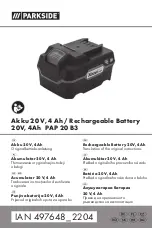
5
11
15.GB
C
Transportation and Commissioning
1
Transporting the charger
F
Always wear solid leather safety boots and
gloves when transporting and assembling
the charger.
Before starting the charger make sure it is
complete and in satisfactory working order.
2
Charger Assembly
F
The battery charger must not be operated
outdoors.
M
Fire hazard Flammable materials must not
be located in the immediate vicinity of the
battery charger. This includes transport and
packaging material delivered with the unit.
- No flammable materials must be located
within 2.5 metres of the battery charger
Choose the assembly location so that:
- There is sufficient ventilation.
- The flow of cooling air through the
charger is not restricted. It must not be
installed close to radiators or similar heat
sources.
- No flammable gases or dust mixtures
can penetrate inside the charger.
- The charger is placed only on a solid and
secure surface. The surface must not
consist of flammable material.
F
It is forbidden to store food in the vicinity of
battery chargers.
Z
The VDE 0510 safety regulations must be
observed.
Operations to be carried out before
assembly or installation of the battery
charger
Procedure
- Remove packaging material (film or
cardboard).
- If the battery charger was delivered on a
transport pallet, lift the battery charger
from the transport pallet
Z
This does not apply to pallets on which the
battery charger is permanently mounted.
These pallets have a fireproof base.
- Packaging material is to be disposed of
correctly.
Z
In addition to the restrictions listed in the
operating instructions, national require-
ments must be observed when choosing
the place of installation.
3
Starting up the charger
Charging cable connection:
The SLT 100 charger is supplied with
a charging cable.
The charging cable connections with strain
relief can be accessed when the yellow
panel is opened.
M
Use only the charging cables provided by
the manufacturer.
Mains connection:
M
All operations involving the opening of the
charger must be performed solely by
trained and authorized electricians.
F
Remove the battery and mains plugs before
opening the charger.
The mains voltage must correspond with
the mains voltage indicated on the
identification label. The identification label
is located on the rear wall of the unit.
M
Fuse protection of the mains cable to the
battery charger is the responsibility of the
customer. The fuse must have a delay-
action release characteristic. Where
automatic cut-outs are used, they must
have a D, S or K rating (for the rated current
consumption of the charger see data plate).
To ensure adequate selectivity, the backup
fuse should at least be 10 % above the
current consumption of the charger.
The charger must be protected against
excessive contact voltage in accordance
with the regulations of the local electricity
provider.
12
11
15.GB
5.2
Large battery charger
- Primary:
F2 control fuse contactors (18)
Secondary:
F1 fuse (3)
electrolyte circulation pump/
Aquamatik (
o
):
F3 fuse (17)
- D400V devices without neutral
conductor:
F12 fuse (19)
M
Version and rated value of the fuses must
not be changed. Refer to label showing the
rated values.
18
F2
17
F3
19
F12
3
F1
Summary of Contents for SLT 100
Page 1: ...SLT 100 SLT 100 Operating instructions 50451882 SLT 100 G 10 04 11 15...
Page 4: ...I2 0709 GB...
Page 23: ......
Page 24: ......









































